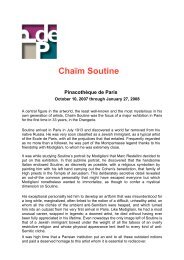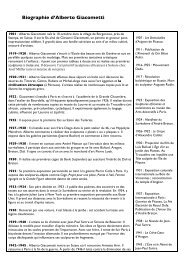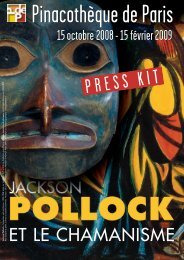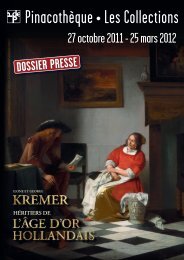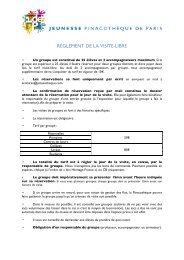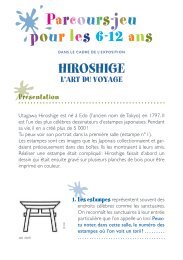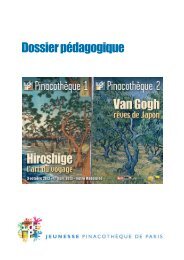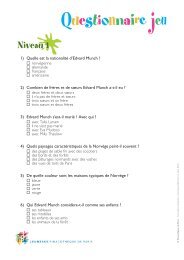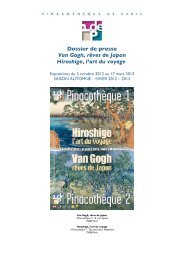Download - Pinacothèque de Paris
Download - Pinacothèque de Paris
Download - Pinacothèque de Paris
Create successful ePaper yourself
Turn your PDF publications into a flip-book with our unique Google optimized e-Paper software.
oils featuring the conceit of giant brushstrokes across the canvas. The following<br />
year, he creates land and seascapes using industrial material such as Plexiglas,<br />
metal, motors, lamps and multi-lensed plastic called Rowlux, which gives the<br />
illusion of shimmer. In 1967, he begins his Mo<strong>de</strong>rn paintings series inspired by<br />
the Art Deco motifs of Radio City Music Hall in Manhattan’s Rockefeller Center<br />
and introduces the look of graduating Benday dots in his work. That fall, he<br />
creates his first large-scale editioned sculptures in brass and tinted glass based<br />
on Deco patterns. Modular paintings soon follow with repeated <strong>de</strong>sign imagery.<br />
In 1968, Lichtenstein marries Dorothy Herzka whom he had met earlier at the<br />
Bianchini Gallery in New York. Lichtenstein’s work appears twice on the cover of<br />
Time magazine that year. In 1969, inspired by serial imagery of Clau<strong>de</strong> Monet,<br />
Lichtenstein introduces the subject of haystacks and Rouen Cathedral seen at<br />
different times of day. The motif launches his return to printmaking in earnest<br />
and begins his long-term collaboration with Gemini G.E.L. in California. He also<br />
makes his first and only film for LACMA’s Arts and Tecnology project.<br />
Mirrors and entablatures dominate his production in 1970. The following year,<br />
Lichtenstein leaves Manhattan to live and work full time in Southampton, on the<br />
eastern end of Long Island. Borrowing motifs from the works of Mo<strong>de</strong>rn masters,<br />
Lichtenstein spends the next years creating still lifes that synthesize his, and their,<br />
signature styles. He also begins to experiment with newcolors and surface<br />
textures in his paintings. Bronze enters his repertoire of materials in 1977 in the<br />
form of painted large-scale sculptures of illuminated lamps, pitchers on tables,<br />
and steaming cups of coffee. The following year, he reintroduces Native<br />
American subjects to his oeuvre. By the end of the <strong>de</strong>ca<strong>de</strong>, Lichtenstein’s Still<br />
Lifes, Heads and Landscape studies have run the gamut of stylistic conceits from<br />
Cubism to Surrealism and German Expressionism.<br />
In the 1980s, Lichtenstein <strong>de</strong>ci<strong>de</strong>s to re-establish a studio in Manhattan, first<br />
taking space on East 29th Street and later buying a building in Manhattan’s<br />
West Greenwich Village meatpacking district. He turns his focus to the markings<br />
of abstract style. Exploring i<strong>de</strong>as about Abstract Expressionism, he juxtaposes<br />
unstructured brushwork alongsi<strong>de</strong> his signature replicas of brushstrokes. Several<br />
years later, beginning in 1985, geometric abstraction receives similar attention<br />
in his Perfect, Imperfect and Plus and Minus series. By the <strong>de</strong>ca<strong>de</strong>’s close,<br />
reflection is a predominate theme of his work where iconic and less familiar<br />
motifs of his Pop art repertoire are reconfigured in a bold new compositional<br />
format.<br />
Colossal home interiors culled from small ads in the telephone yellow pages are<br />
16



